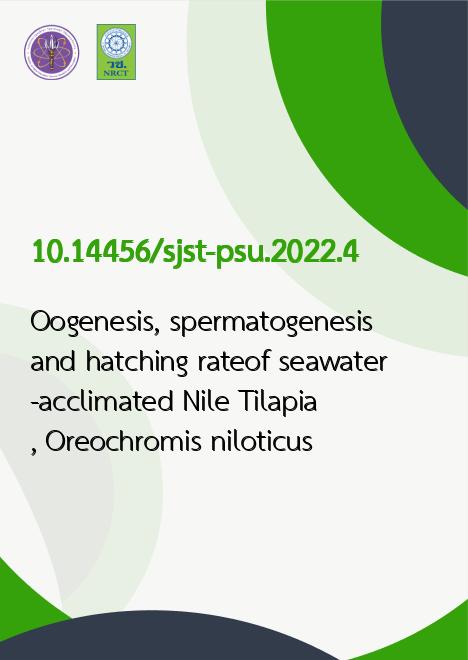
|
Oogenesis, spermatogenesis and hatching rateof seawater-acclimated Nile Tilapia, Oreochromis niloticus |
|---|---|
| รหัสดีโอไอ | |
| Creator | 1. Biboon Withyachumnarnkul 2. Behnam Foroutan 3. Chompoonut Kerdmusik 4. Rapeepun Vanijviriyakij 5. Boonsirm Withyachumnarnkul |
| Title | Oogenesis, spermatogenesis and hatching rateof seawater-acclimated Nile Tilapia, Oreochromis niloticus |
| Publisher | Research and Development Office, Prince of Songkla University |
| Publication Year | 2565 |
| Journal Title | Songklanakarin Journal of Science an Technology (SJST) |
| Journal Vol. | 44 |
| Journal No. | 1 |
| Page no. | 21-25 |
| Keyword | reproduction, seawater-acclimated Nile tilapia, Oreochromis niloticus, embryonic tolerance, gonadal development, hatching |
| Abstract | Seawater (SW)-acclimated Nile tilapia, Oreochromis niloticus, can grow and survive but rarely have offspring under anelevated salinity environment. To find out the cause(s) of this problem, the size and histology of the gonads of the SWacclimated Nile tilapia were determined, which revealed that the gonadosomatic index and histology of the gonads of the SWacclimated fish did not differ from those of the freshwater (FW)-acclimated ones. However, the embryos of the SW-acclimatedO. niloticus could tolerate salinity from 0 to 15 ppt, with a survival rate of embryos more than 80%, but 0% under 20-ppt.However, when the embryos were incubated under 10 ppt up to the stage of eye formation, and thereafter the salinity wasabruptly raised to 20 ppt, >90% of them survived. The results suggested that SW-acclimated O. niloticus have normal oogenesisand spermatogenesis, and their embryos can survive salinity above 15 ppt if the salinity is raised stepwise. |
